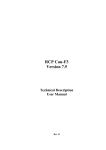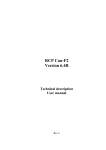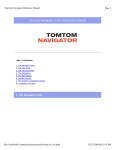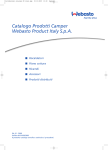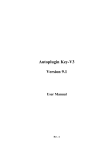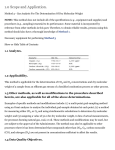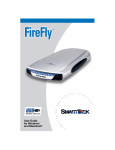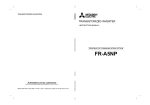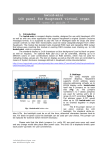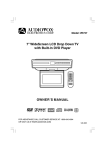Download User manual - Autoplugin
Transcript
RCP Can-V1R Version 7.1 Technical description User manual Rev. C 2 Table of Contents Description………………………...………………………………….……………2 Module Possibilities………………………………………………………………..2 Package Content……………………………………………………………………2 Signals………………………………………………………………………...……2 Connection…………………………………………………………………………6 Basic Functions…………………………………………………………………….6 Additional Functions………………………………………………………….……6 Troubleshooting………………………………………………………………...…10 Glossary…………………………………………………………………………...11 Description The RCP Can-V1R module is intended for remote control connection to the fuelfired heater (parking heater, fuel operated heater, pre-heater), which was factory equipped on Volvo S60 (2005-2010), V70 (2005-2007), XC70 (2005-2007) и XC90 (2005-), including the original Volvo vehicle key. The device controls the heater via CAN-bus. Module Possibilities · · · · The heater start and stop by various impulses Heater status signals Embedded remote control of the heater by the original Volvo vehicle key Remote cancellation of the heater start, programmed by the driver information system · Main battery protection from discharging by inspection of the voltage level and time of autonomous work of the heater Package Content 1. 2. 3. 4. RCP Can module Wiring Technical description brochure Installation manual brochure Signals The module has two connectors: 9-pin connector X1 (table 1) for input signals and power connection, 10-pin connector X2 (table 2) for output signals, special signals and CAN-bus connection. The first pin on each connector is marked by the key. 3 X1.1 Heater_off+1 The input can be used to switch off the heater, operated in pre-heat mode, by the impulse of positive polarity (the input Heater_off- in that case has to be connected to the Ground). The heater is stopped by the leading edge of the impulse. If the heater is idle, positive impulse on this input cancels the timer start of the heater, programmed by DIS. Table 1 The signals to be necessarily connected is marked in the table by Italics X1 pin Signal Name Polarity Wire colour number 1 Heater_off+ + White 2 Heater_offGrey 3 Heater_on+ + Green 4 Heater_onBlue 5 Button Brown 6 Ventilation + Orange 7 RC_in + Yellow 8 Ground Black 9 Battery Power Red Table 2 The signals to be necessarily connected is marked in the table by Italics X2 pin Signal Name Polarity Wire colour Maximum number Electric Load*, mА 1 RC_out + Blue-white 500 2 Heater_Status Yellow 500 3 Alert_1 Grey 500 4 Alert_2 Orange 500 5 Timer_out Blue 500 6 Indication + Red-white 1000 7 Sensor_In Green-yellow 8 Sensor_Out Green 500 9 CAN-L Brown-white 10 CAN-H Brown *The connection of outputs 2-5 directly to the Power, without a load, is not permitted. The connection of outputs 1 and 6 directly to the Ground, without a load, is not permitted 4 X1.2 Heater_off-1 The input can be used to switch off the heater, operated in pre-heat mode, by the impulse of negative polarity (the input Heater_off+ in that case has to be connected to the Power). The heater is stopped by the leading edge of the impulse. If the heater is idle, negative impulse on this input cancels the timer start of the heater, programmed by DIS. This input is suitable for the most alarm systems and GSM-modules connections in order to control the heater remotely. X1.3 Heater_on+1 The input can be used to switch the heater on by the impulse of positive polarity (the input Heater_on- in that case has to be connected to the Ground). The heater is started by the leading edge of the impulse. X1.4 Heater_on-1 The input can be used to switch the heater on by the impulse of negative polarity (the input Heater_on+ in that case has to be connected to the Power). The heater is started by the leading edge of the impulse. This input is suitable for the most alarm systems and GSM-modules connections in order to control the heater remotely. X1.5 Button The input for connection of outer button. The button may be used for the direct start and stop of the heater X1.6 Ventilation The input is not used in current version X1.7 RC_in The input can be used to switch the heater on/off by an impulse of positive polarity. The heater is turned on by the leading edge of an impulse and is turned off by the trailing edge of the impulse. The specialized remotes such as Smart Start, Easy Start and Telestart can be connected to this input1. GSM-modules with a potential signal on the control channel also may be connected to the input. X1.8 Ground 1 X1.9 Power +12V 1 X2.1 RC_out The input is used to inform the remote control unit that the heater has been switched off. When the heater is switched off, the impulse of positive polarity with 0.5 second duration appears on the output. When the engine is running, the output is permanently pulled up to the Power. For Defa Smart Start remote control the input is connected to the blue wire of Defa Vehicle Unit 5 X2.2 Status The assignment of this output is defined by the setting 7.5. By default the signal “Heater operates autonomously” is given on the output. X2.3 Alert_1 The signal is used to receive a notification to remote control (if remote is compatible to alerts receiving). The assignment of this output is defined by the setting 7.3. When programmed event is occurred, the impulse of negative polarity with 1 second duration appears on the output. By default the signal “Heater started” is given on the output. X2.4 Alert_2 The signal is used to receive a notification to remote control (if remote is compatible to alerts receiving). The assignment of this output is defined by the setting 7.4. When programmed event is occurred, the impulse of negative polarity with 1 second duration appears on the output. By default the signal “Heater stopped” is given on the output. X2.5 Timer_out The output can be used to control an external device by time of the heater operation. Time of signal appearing is defined by the setting 5.1. When the heater operates programmed time, the impulse of negative polarity with 1 second duration appears on the output. X2.6 Indication The output can be used for connection of stand alone or button built-in indicator, which will inform you about heater run-time errors. X2.7 Sensor_In Not used X2.8 Sensor_Out Not used X2.9 CAN-L Low-level CAN bus line has to be connected to the green wire of LOSPEED CAN bus1. X2.10 CAN-H High-level CAN bus line has to be connected to the white wire of LOSPEED CAN bus1. 1 - See installation manual for connection details 6 Connection RCP Can is recommended for professional installation. It needs at least some experience in car electronics installation. See installation manual for detailed connection schemes. Note that RCP Can was not tested with Volvo vehicles with no software for the heater control in DIS (2 timers and direct start/stop function). Therefore it may be necessary to load the software to DIS by Volvo dealer equipment. Basic Functions 1. To start/stop the heater by additional remote control, see documentation for the remote control. The functions of the remote control depend on its possibilities, connection schemes and module’s settings. 2. To start the heater by the original Volvo key, press the yellow button on the key to turn the perimeter lighting on. Then press “Lock” button twice within 30 seconds, while lighting is on. After the last pressing, the module will turn the lighting off to confirm the heater startup. 3. To stop the heater by the original Volvo key, twice turn on and then off the perimeter lighting by the yellow button, when the heater operates. The intervals between yellow button presses should not exceed 20 seconds. 4. You can remotely cancel the start of the heater by a DIS timer: send the stop command by remote control for the idle heater. After stop command sending, DIS timers will be temporary disabled. Start the heater by any way or turn the ignition on will enable DIS timers again. 5. An additional button may be connected to the module. The button is used for immediate start or stop of the heater. Button press changes a heater condition to another one: switches off the operated heater or switches on the idle heater. Additional Functions By default RCP Can is adjusted to execute basic functions, such as start and stop of the heater by the Volvo key or by additional button. To turn on additional functions (ex. battery monitoring) you may enter the module into programming mode and activate the corresponding setting. The left-side steering wheel lever and the brake pedal are used to enter programming mode and to the settings change. It is necessary to stop the engine and the heater before. Turn the ignition on, press and hold the brake pedal. Twist the lever’s ring some steps to turn off the left display in DIS. Then press and hold 7 at least for 5 seconds “Read” button. Both turn signal repeaters in DIS will flash twice as a confirmation of entering programming mode. Release the brake pedal and “Read” button now. Each setting in the table 3 corresponds to the 3-digit code. You need to enter appropriate code to activate a setting. To enter a digit of a code, shortly press “Reset” button on the lever so much times, as corresponds to a digit. Each button press will be confirmed by a turn signal repeater of DIS: the left turn to the first and the third digits of code, the right turn to the second digit of code. To confirm a digit entering, press and release “Read” button (DIS will flash one time by the both repeaters simultaneously). After the third digit will be entered, module will check the code for validity and confirm it by repeaters: flash twice by the both repeaters simultaneously in the case of valid code, flash twice by the both repeaters alternately in the case of invalid code. If you made a mistake with the number of button presses when you enter the code, press and release “Read” button until the module will indicate an error by repeaters. Enter the code again in that case. Also you may enter other codes without exit of programming mode. Turn the ignition off to exit programming mode. New settings will be saved in the module’s memory and will be stored there regardless of whether the module is connected or not. Attention: If you start the engine without exit of programming mode, new settings will not be saved in memory. To reset the module to factory settings, enter the code 8.1.1. Both repeaters will flash three times to confirm command execution, and then the module will exit of programming mode and will restart. Settings Table (3) * Factory setting Recommended settings is marked in italics Settings Group 1. Heater Timing Setting Possible Values 1.1. Limitation of heater’s total operational time in pre-heat mode 1.1.1 1.1.2 1.1.3 1.1.4 1.1.5 1.1.6 1.1.7 1.1.8 1.1.9 Not adjusted 40 minutes 50 minutes 60 minutes *70 minutes 80 minutes 90 minutes 100 minutes 120 minutes 8 1.2. Limitation of heater’s 1-cycle operational time in pre-heat mode 2. Heater Control by Volvo Key 3. Battery Monitoring 2.1. “Lock” and “Yellow” button functions for the heater control 2.2. Number of sequential turning on and then turning off the perimeter lighting by “Yellow” button for the heater control 2.3. Number of sequential “Lock” button presses for the heater control (with the perimeter lighting turned on) 3.1. Minimal voltage to let the heater start in preheat mode 3.2. Minimal voltage to keep operating the heater for pre-heat mode 2 1.2.1 10 minutes 1.2.2 15 minutes 1.2.3 20 minutes 1.2.4 25 minutes 1.2.5 30 minutes 1.2.6 40 minutes 1.2.7 50 minutes 1.2.8 60 minutes 1.2.9 *70 minutes 2.1.1 *”Lock” button to the heater startup, yellow button to the heater stop 2.1.2 Yellow button to the heater startup, “Lock” button to the heater stop 2.2.1 Heater control by “Yellow” button disabled 2.2.2 Two times 2.2.3 Three times 2.2.4 *Four times 2.3.1 Heater control by “Lock” button disabled 2.3.2 Two presses 2.3.3 Three presses 2.3.4 *Four presses 3.1.1 3.1.2 3.1.3 3.1.4 3.1.5 3.1.6 3.1.7 3.1.8 3.1.9 3.2.1 3.2.2 3.2.3 3.2.4 3.2.5 3.2.6 3.2.7 3.2.8 * Not adjusted 11.8V 11.8V 11.9V 12.0V 12.1V 12.2V 12.3V 12.4V * Not adjusted 11.4V 11.5V 11.6V 11.7V 11.8V 11.9V 12.0V 9 4. Timer Out Control 6. Heater startup and stop indication by the perimeter lighting 4.1. Activate the Timer_Out line by time of the heater autonomous operation 4.3. Activate the Timer_Out line directly by the start command resend via the “Heater_On” line 6.1. Indication of the heater startup 6.2. Indication of the heater stop 7. Output signals adjustment 7.3. Notification signals on the output “Alert_1” 2 7.4. Notification signals on the output “Alert_2” 7.5. Signals on the output “Status” 4.1.1 4.1.2 4.1.3 4.1.4 4.1.5 4.1.6 4.1.7 4.1.8 4.1.9 4.3.1 4.3.2 *Don’t activate In 10 minutes after the heater startup In 15 minutes after the heater startup In 20 minutes after the heater startup In 25 minutes after the heater startup In 30 minutes after the heater startup In 40 minutes after the heater startup In 50 minutes after the heater startup In 60 minutes after the heater startup *Off On 6.1.1 6.1.2 6.1.3 6.1.4 6.1.5 6.1.6 6.1.7 *Off (only switching off the lighting) Switch the lighting on for 1 sec Switch the lighting on for 2 sec Switch the lighting on for 3 sec Switch the lighting on for 5 sec Switch the lighting on for 7 sec Switch the lighting on for 10 sec 6.2.1 *Off (only switching off the lighting) 6.2.2 Switch the lighting on for 1 sec 6.2.3 Switch the lighting on for 2 sec 6.2.4 Switch the lighting on for 3 sec 6.2.5 Switch the lighting on for 5 sec 6.2.6 Switch the lighting on for 7 sec 6.2.7 Switch the lighting on for 10 sec 7.3.1 *"Heater started" 7.3.2 "Heater stopped" 7.3.5 "Heater started to burn" 7.3.7 "Error occurred" 7.3.8 Disable the output 7.4.1 "Heater started" 7.4.2 *"Heater stopped" 7.4.5 "Heater started to burn" 7.4.7 "Error occurred" 7.4.8 Disable the output 7.5.1 Heater operates (potential) 7.5.2 *Heater operates autonomously (from battery, engine is off) (potential) 10 7.5.3 Heater operates autonomously (double impulses with the frequency adjusted by 6.7, applying settings 6.3-6.5)3 7.5.4 Engine runs (potential) 7.5.5 Engine runs (RPM impulses) 7.5.6. Disable the output 8.1.1 Apply factory settings 8. Settings reset 1 –RCP will turn off the heater if the battery voltage becomes lower than presetted – Signals appears only at the heater autonomous operation 3 – Signal is used for indication by all the hazard flashers. It uses 1-wire connection to the hazard alarm button (see installation manual for details). Indication by the turn signals via CAN-bus is switched off 2 Troubleshooting If a run-time error occurs at the start of the heater, RCP Can will inform you by the built-in and an additional LEDs blinking about the error code. The number of flashes corresponds to the error code. See table 4 for the codes description and possible solutions. Table 4 Error Code 1 2 Error Description Wrong heater configuration No answer from the heater followed the start command Possible Reasons of Error Appearance The heater is not activated in DIS The engine is hot (no need to pre-heat) The heater hasn’t finished previous cycle of operation yet (you can hear the noise from the air blower fan) Fuel level in the tank is close to empty (“Fuel Low” warning indicator is lighting in DIS) The heater is blocked after 3 unsuccessful starts Solutions Configure the heater by Volvo car dealer equipment Let the engine cool down below +75 degrees The heater will startup after previous cycle of operation will be fully completed Refuel your vehicle Try to start the heater from DIS menu. If it not started to burn, make a diagnostics of the heater. 11 3 Battery level is low 4 Time limits exceeded 5 Unsuccessful start 6 Operation cycle too short CAN-bus error 8 9 Settings error 11 Heater no connection The module has determined that the battery voltage at the heater startup or during the heater operation is below the specified settings 3.1 и 3.2 Time limit for autonomous operation of the heater is achieved (with active setting 1.1) The heater was switched off spontaneously at a startup The heater was switched off spontaneously Charge vehicle’s battery with special charger (or start engine to charge) or cancel 3.1/3.2 module’s settings There is a problem with connection of the module to the CAN-bus Settings have been incorrectly stored in RCP memory The heater is unplugged from CAN-bus or is out of order Check for the module’s connection Run the engine or cancel 1.1 module’s setting Make a diagnostics of the heater if the error is repeated Make a diagnostics of the heater if the error is repeated Reset the settings (8.1.1), readjust RCP Make a diagnostics of the heater Glossary CAN - Control Area Network (digital network for data transfer in vehicles) RCP - Remote Control Plug-in (electronic module for the heater remote control) DIS - Driver Information System of the instrument cluster © Autoplugin ES www.autoplugin.de














